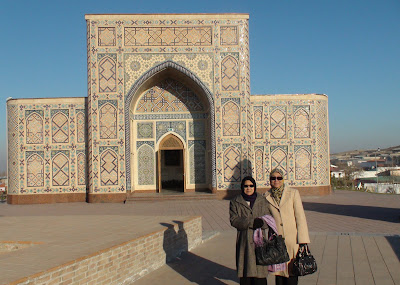
The Ruhabad Mausoleum as viewed from a hotel’s balcony.
Sheikh Burhan ad-din Sagaraji was the head of Muslims of Peking between 1345 and 1346. At that time, Peking was the capital of Mongol-Chinese Yuan Empire. The Ruhabad ("The House of Spirit") Mausoleum was built above the tombs of Sheikh Burhan ad-din Sagaraji and his sons. It is also believed that Sheikh Burhan ad-din's wife, the "Chinese Princess", was buried there too. According to some legends, a copper box with seven hairs of Prophet Muhammad had been hidden in the Ruhabad Mausoleum's dome.
SOURCE: Arapov A. V., Samarkand: Masterpieces of Central Asia, SMI-ASIA, Tashkent-Moscow, 2008.
The Gur-Emir ("The Burial Vault of Emir") is the family cemetery of Amir Timur where Amir Timur and his remarkable grandson, Mirzo Ulugbeg, were buried.
SOURCE: Arapov A. V., Samarkand: Masterpieces of Central Asia, SMI-ASIA, Tashkent-Moscow, 2008.

The entrance of the Gur-Emir Mausoleum.

The décor inside the Gur-Emir Mausoleum.

The Observatory of Ulugbeg.
During the Middle Ages, astronomy was considered as one of the leading fields of Islamic science. Omar Khayyam and Nasr ad-din Tusi made astronomical observations and recorded them in a variety of astronomical tables. Mirzo Ulugbeg wanted to continue these observations and correct them if possible. Thus, in 1420, Ulugbeg ordered to build in Samarkand the biggest observatory of that time. With the help of this observatory, Ulugbeg and his team of astronomers successfully produced "Zijj of Ulugbeg", a theoretical introductory part and catalogue of 1018 stars.
However, in the late Middle Ages, the observatory was destroyed and "disappeared". In 1648, European scientists realized about the existence of this observatory when a part of "Zijj of Ulugbeg" was published in Oxford. In 1908, V. Vyatkin (Samarkand archeologist) found the observatory's ruins on Kuhak Hill which then led to further excavations in 1941 and 1948.
The archeologists discovered that the observatory was a huge three-level building that had the shape of a cylinder with the dimensions of about 46 meters in diameter and 30 meters high. They also found, under the ground, an enormous mural sextant that was used to measure the positions of stars.
SOURCES:

Arapov A. V., Samarkand: Masterpieces of Central Asia, SMI-ASIA, Tashkent-Moscow, 2008.
http://en.wikipedia.org/wiki/Ulugh_Beg
The mural sextant to measure the positions of stars, inside the Observatory of Ulugbeg.
SOURCES:
Arapov A. V., Samarkand: Masterpieces of Central Asia, SMI-ASIA, Tashkent-Moscow, 2008.
http://en.wikipedia.org/wiki/Sextant_(astronomical)
http://en.wikipedia.org/wiki/Sextant_(astronomical)

Replicas of the three-storey Observatory of Ulugbeg and the double quadrant, inside the Memorial Museum of Ulugbeg.

Star constellations mapped onto the ceiling of the Memorial Museum of Ulugbeg.

The text displayed inside the Memorial Museum of Ulugbeg.

The new facade of the Memorial Museum of Ulugbeg after the renovation in 2010.

The Mausoleum of Prophet Danial on the Afrasiab hill.
According to a legend, Prophet Danial @ Khoja Daniyar was one of the first preachers of Islam in Samarkand. Prophet Danial is a character that exists in Al-Quran and the Bible. Therefore, the tomb of Prophet Danial is respected by both the Muslims and the Christians.
SOURCE: Arapov A. V., Samarkand: Masterpieces of Central Asia, SMI-ASIA, Tashkent-Moscow, 2008.

A small cave near the Mausoleum of Prophet Danial.

The tomb of Prophet Danial.

The Hazret-Hyzr Mosque.
The mosque is named after an Islamic saint, Hazret-Hyzr, who is also known as “Eternal Wanderer”. A legend says that the place where the mosque is built had been visited by Hazret-Hyzr. Originally, there was a pagan temple at the site of the mosque. However, in the early years of Islam in Samarkand, the pagan temple was transformed into a mosque. The present mosque was constructed in 1854 on the same foundations of the ancient mosque. The mosque then had been renovated and redecorated several times, over the years.
SOURCE: Arapov A. V., Samarkand: Masterpieces of Central Asia, SMI-ASIA, Tashkent-Moscow, 2008.

A panoramic view of Samarkand City from the Hazret-Hyzr Mosque.

The Shah-i-Zindah Ensemble.
The name "Shah-i-Zindah", which means "The Underground King", refers to Kusam ibn Abbas. Kusam ibn Abbas, a cousin of Rasulullah, is believed to have died at the Walls of Samarkand when Moslems were attacked during a prayer. The two legends linked to Kusam's death conclude that Kusam may still be alive and is hiding under the earth of Samarkand.
Shah-i-Zindah is the scene of action where Kusam was killed. The mausoleum of Kusam ibn Abbas was constructed at this place in the 11th century and has been visited by Ibn Battuta (a famous Arabian traveler) in 1330's.
SOURCE: Arapov A. V., Samarkand: Masterpieces of Central Asia, SMI-ASIA, Tashkent-Moscow, 2008.

The ruins of an ancient bath which was built in the early 16th century.
SOURCE: Arapov A. V., Samarkand: Masterpieces of Central Asia, SMI-ASIA, Tashkent-Moscow, 2008.

With a group of Samarkand ladies at the entrance portal of Shah-i-Zindah which was built in the 15th century.
SOURCE: Arapov A. V., Samarkand: Masterpieces of Central Asia, SMI-ASIA, Tashkent-Moscow, 2008.


